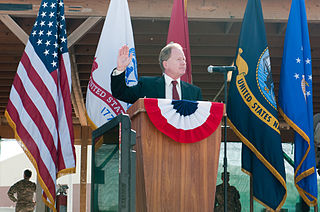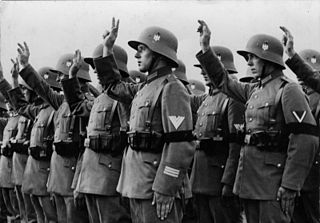An allegiance is a duty of fidelity said to be owed, or freely committed, by the people, subjects or citizens to their state or sovereign.

An oath of office is an oath or affirmation a person takes before assuming the duties of an office, usually a position in government or within a religious body, although such oaths are sometimes required of officers of other organizations. Such oaths are often required by the laws of the state, religious body, or other organization before the person may actually exercise the powers of the office or organization. It may be administered at an inauguration, coronation, enthronement, or other ceremony connected with the taking up of office itself, or it may be administered privately. In some cases it may be administered privately and then repeated during a public ceremony.

The Pledge of Allegiance is a patriotic recited verse that promises allegiance to the flag of the United States and the republic of the United States of America. The first version, with a text different from the one used at present, was written in 1885 by Captain George Thatcher Balch, a Union Army officer in the Civil War who later authored a book on how to teach patriotism to children in public schools. In 1892, Francis Bellamy revised Balch's verse as part of a magazine promotion surrounding the World's Columbian Exposition, which celebrated the 400th anniversary of Christopher Columbus' arrival in the Americas. Bellamy, the circulation manager for The Youth's Companion magazine, helped persuade then-president Benjamin Harrison to institute Columbus Day as a national holiday and lobbied Congress for a national school celebration of the day. The magazine sent leaflets containing part of Bellamy's Pledge of Allegiance to schools across the country and on October 21, 1892, over 10,000 children recited the verse together.
The Irish Oath of Allegiance was a controversial provision in the Anglo-Irish Treaty of 1921, which Irish TDs and Senators were required to swear before taking their seats in Dáil Éireann and Seanad Éireann before the Constitution Act 1933 was passed on 3 May 1933. The controversy surrounding the Oath was one of the principal issues that led to the Irish Civil War of 1922–23 between supporters and opponents of the Treaty.

An oath of allegiance is an oath whereby a subject or citizen acknowledges a duty of allegiance and swears loyalty to a monarch or a country. In modern republics, oaths are sworn to the country in general, or to the country's constitution. For example, officials in the United States, take an oath of office that includes swearing allegiance to the United States Constitution. However, typically in a constitutional monarchy, such as in the United Kingdom, Australia, and other Commonwealth realms, oaths are sworn to the monarch. Armed forces typically require a military oath.

The Canadian Oath of Allegiance is a promise or declaration of fealty to the Canadian monarch—as personification of the Canadian state and its authority, rather than as an individual person—taken, along with other specific oaths of office, by new occupants of various federal and provincial government offices; members of federal, provincial, and municipal police forces; members of the Canadian Armed Forces; and, in some provinces, all lawyers upon admission to the bar. The Oath of Allegiance also makes up the first portion of the Oath of Citizenship, the taking of which is a requirement of obtaining Canadian nationality.
Speiser v. Randall, 357 U.S. 513 (1958), was a U.S. Supreme Court case addressing the State of California's refusal to grant to ACLU lawyer Lawrence Speiser, a veteran of World War II, a tax exemption because that person refused to sign a loyalty oath as required by a California law enacted in 1954. The court reversed a lower court ruling that the loyalty oath provision did not violate the appellants' First Amendment rights.
An oath of citizenship is an oath taken by immigrants that officially naturalizes immigrants into citizens. It is often the final step in this process, and is usually done in a ceremonial capacity. An oath of citizenship is designed to be a statement of patriotism and loyalty to the new country. In countries which retain a monarchical system of government, an oath of allegiance to the monarch is often required as well. Adding an oath to God to the end of an oath is usually optional.
The Government of New South Wales, also known as the NSW Government, is the executive branch of the Australian state of New South Wales, and is empowered by the state Constitution. Since Federation in 1901, New South Wales has been a state of Australia, and the federal Constitution regulates its relationship with the Commonwealth. Under the Australian Constitution, all states ceded legislative and judicial supremacy, but retained powers in all matters not in conflict with the Commonwealth.

The Oath of Allegiance is a promise to be loyal to the British monarch, and his or her heirs and successors, sworn by certain public servants in the United Kingdom, and also by newly naturalised subjects in citizenship ceremonies. The current standard wording of the oath of allegiance is set out in the Promissory Oaths Act 1868.

The Oath of Citizenship, or Citizenship Oath, is a statement recited and signed by those who apply to become citizens of Canada. Administered at a ceremony presided over by a designated official, the oath is a promise or declaration of fealty to the Canadian monarch and a promise to abide by Canada's laws and uphold the duties of a Canadian citizen; upon signing the oath, citizenship is granted to the applicant.

The Oath of Allegiance of the United States is the official oath of allegiance that must be taken and subscribed by every immigrant who wishes to become a United States citizen.

The Hitler Oath —also referred in English as the Soldier's Oath—refers to the oaths of allegiance sworn by officers and soldiers of the German Armed Forces and civil servants of Nazi Germany between the years 1934 and 1945. The oath pledged personal loyalty to Adolf Hitler in place of loyalty to the constitution of the country. Historians view the personal oath of the Third Reich as an important psychological element to obey orders for committing war crimes, atrocities, and genocide. During the Nuremberg trials, many German officers unsuccessfully attempted to use the oath as a defence against charges of war crimes and crimes against humanity.
Near the end of the American Civil War, the Ironclad Oath was an oath promoted by Radical Republicans that required federal employees, lawyers, and federal elected officials to swear upon entry of office that they had never supported the Confederacy. The first such law adopted by Congress was in 1862 which attempted to make the oath a requirement for the incoming members of the 38th United States Congress to take the oath. In 1863, President Abraham Lincoln proposed the Ten percent plan, which proposed that a state in rebellion could be reintegrated if a similar oath, with an additional pledge to abide by the nationwide abolition of slavery, was taken by 10% of its voters. Congress then attempted to raise this to 51% of voters in the Wade–Davis Bill of 1864, which Lincoln pocket vetoed on the grounds that it was too harsh. After the assassination of Lincoln in 1865, his successor, Andrew Johnson, opposed the oath altogether. Given the temporary disenfranchisement of the numerous Confederate veterans and local civic leaders, a new Republican biracial coalition came to power in the eleven Southern states during Reconstruction. Southern conservative Democrats were angered to have been disenfranchised.

The Lieberman Plan, also known in Israel as the "Populated-Area Exchange Plan", was proposed in May 2004 by Avigdor Lieberman, the leader of the Israeli political party Yisrael Beiteinu. The plan suggests an exchange of populated territories – territories populated by both Arabs and Jews – between Israel and the Palestinian Authority.
In Australia, an Oath of Allegiance or an Affirmation of Allegiance are oaths of allegiance required to be made to the monarch of Australia in some situations. Oaths of Allegiance are usually made on a Bible, or some other book holy to the person, such as a Torah or Koran; but the person may opt to make an affirmation in lieu of an oath. This oath is not the same as the Australian Citizenship Pledge which is required to be made when being naturalised as an Australian citizen.
The Oath of Allegiance is an oath administered to and recited by immigrants who wish to accede to the citizenship of the Republic of the Philippines. The current oath, based on the United States Oath of Allegiance, was first enshrined in Commonwealth Act No. 473, the Revised Naturalization Law of 1939, with the modern version enshrined in Republic Act No. 9225, the Citizenship Retention and Re-acquisition Act of 2003.
The Levering Act was a law enacted by the U.S. state of California in 1950. It required state employees to subscribe to a loyalty oath that specifically disavowed radical beliefs. It was aimed in particular at employees of the University of California. Several teachers lost their positions when they refused to sign loyalty oaths.

The Constitution Amendment (Pledge of Loyalty) Act 2006 No 6, was an Act to amend the Constitution Act 1902 to require Members of the New South Wales Parliament and its Ministers to take a pledge of loyalty to Australia and to the people of New South Wales instead of swearing allegiance to Queen Elizabeth II her heirs and successors, and to revise the oaths taken by Executive Councillors. The Act was assented to by the Queen on 3 April 2006.

The Confederate oath of allegiance, an oath of allegiance to the Confederate States of America, was taken by officers and enlisted men of the CSA (1861–1865) during the American Civil War. In contrast to the American oath of allegiance, Confederates swore "allegiance to the Confederate States without mention of allegiance to their constitution." Confederate oaths varied somewhat by state, and in the spirit of the CSA's proclaimed preference for states' rights over a unified federal government with majority rule and minority rights, Confederate oaths were often made to specific state governments.













